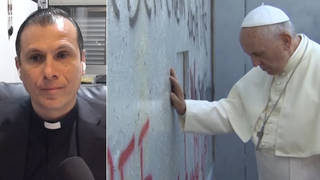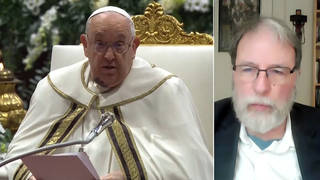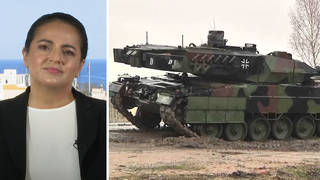
By Amy Goodman & Denis Moynihan
Is a Russian invasion of Ukraine imminent? At the heart of this avoidable catastrophe is Moscow’s concern over the ever-increasing U.S. military threat on its doorstep. Since the Soviet Union fell, the United States, through its NATO allies, has pushed troops and arms closer to Russia, despite the “not one inch eastward” promise made by U.S. Secretary of State James Baker to Soviet leader Mikhail Gorbachev in 1990. Now, close to 100,000 Russian troops are massed on the Ukrainian border. The Ukrainian military is on high alert. Adding fuel to the fire, President Biden ordered 8,500 U.S. troops on high alert and is pouring weapons into Ukraine.
Katrina vanden Heuvel, who has reported on Russia for decades, explained on the Democracy Now! news hour: “Russia, the Soviet Union, lost 27 million people in World War II. There is a real continuing fear, even in younger generations, about being encircled…What if Russian troops suddenly decided to alight in Mexico? Borders matter, especially in the Russian historical consciousness.”
Pope Francis said on Wednesday, “Today, I especially ask you to join in praying for peace in Ukraine,” Invoking Ukraine’s 20th century history, he continued, “More than five million people were annihilated during the time of the last war. They are a suffering people; they have suffered starvation, they have suffered so much cruelty, and they deserve peace…Please: War never again!”
About 30% of Ukraine’s 50 million citizens are native Russian speakers, most in the southeast region of Donbas bordering Russia and on the Crimean Peninsula. Russia militarily annexed Crimea in 2014, as “Euromaidan” protesters in Kyiv’s main square and in other cities demanded closer ties to the European Union. The national debate on whether to align with East or West erupted into a military conflict, with close to 14,000 people killed, 1.5 million displaced, and two regions within the Donbas, Donetsk and Luhansk, declaring independence from Ukraine and aligning with Russia.
Anatol Lieven, a senior fellow at the Quincy Institute for Responsible Statecraft, offered his analysis on Democracy Now!: “The crisis has grown to this point because of Russia’s deep unhappiness with the expansion of NATO to its borders and the threat of NATO admitting Ukraine, which Russia regards in much the same light that America regards the appearance of hostile military alliances in Central America.”
President Kennedy’s confrontation with the Soviet Union during the 1962 Cuban missile crisis is considered the closest we have ever come to all-out nuclear war. Kennedy acted much like Putin is now, engaging in military brinksmanship to deter the deployment of foreign weapons and troops along a national border.
In addition to the mobilization of U.S. troops, the U.S. and NATO allies are shipping weapons to Ukraine. William Hartung, also with the Quincy Institute, has long followed the unchecked growth of Pentagon spending and the weapons manufacturers that profit from war. “The U.S. has sent $2.7 billion in military aid and training to Ukraine since 2014. President Biden is talking about a couple hundred million more. And more, no doubt, will follow,” Hartung said on Democracy Now!
The United States, the biggest spender in NATO, has forced the “2% defense investment guideline” on NATO’s 29 other member nations, pressuring European countries to increase military spending. As NATO states on its website, “In 2014, three Allies spent 2% of GDP or more on defense; this went up to 11 Allies in 2020 and a majority of Allies have national plans in place to meet this target by 2024.” Hartung added, “the tensions that are related to [Ukraine] augur for their ability to keep military spending and military procurement high.”
Thich Nhat Hanh is one peace activist whose voice will be missing throughout this crisis. The legendary Buddist monk and spiritual leader died in his native Vietnam this week at the age of 95.
Considered the founder of the engaged buddhism movement, Thich Nhat Hanh was exiled from Vietnam in 1966 for opposing the war. In his 1967 book “Vietnam: Lotus in a Sea of Fire” he explained how the movement of young buddhists was pushing their less engaged elders: “In a river current, it is not the water in front that pulls the river along, but the water in the rear that acts as the driving force, pushing the water in front forward.”
The U.S. media provides a parade of pro-war politicians and pundits from both the Democratic and Republican parties, while progressive peace advocates are almost entirely shut out. Progressive Congressmembers Pramila Jayapal and Barbara Lee warned the Biden administration on Wednesday, “there is no military solution” to the crisis.
Grassroots movements must demand peace and diplomacy, now, before the outbreak of war.












Media Options